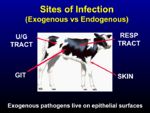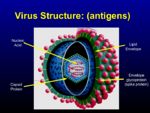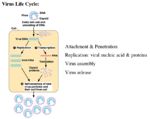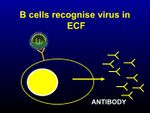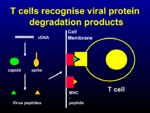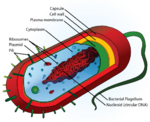Difference between revisions of "Host invasion by microorganisms"
Rjfrancisrvc (talk | contribs) |
|||
| (33 intermediate revisions by 8 users not shown) | |||
| Line 1: | Line 1: | ||
| − | + | <big><big><center>[[WikiBlood|'''BACK TO WikiBlood''']]</center></big></big> | |
| + | <br> | ||
| + | <big><center>[[Immunology - WikiBlood|'''BACK TO IMMUNOLOGY''']]</center></big> | ||
| + | ---- | ||
| + | =Introduction= | ||
| + | [[Image:Routes of Infection.jpg|thumb|right|150px|Routes of Infection - B. Catchpole, RVC 2008]] | ||
| + | Infection is a primary cause of disease. Four pathways of infection are identified: bacterial, viral, fungal, and parasitic, comprising protozoa and worms (helminths). In all cases, microorganisms can display similar characteristics. They can manifest as '''primary (obligate) pathogens''' or '''secondary (opportunistic) pathogens''', the former of which always corresponds to disease, and the latter of which depends on prerequisites being fulfilled before causing disease. As such, secondary pathogens can be found in healthy animals, but they lie in wait until a primary cause compromises the immune system and then manifest symptoms. Secondary pathogens can even masquerade as '''commensal''' organisms, or those which operate in harmony with the animal, until they become pathogenic. | ||
| − | + | Microorganisms can enter the body by three routes: '''contact''' (typically dermatological infection), '''aerosol''' (typically respiratory infection), or '''orofecal''' (typically enteric infection). Infection can be either '''exogenous''' (via entry to epithelial surfaces) or '''endogenous''' (intracellular, extracellular, or vesicular). | |
| − | |||
| − | |||
| − | |||
| − | |||
| − | + | =[[Viruses - WikiBlood|Viruses]]= | |
| − | + | [[Image:Virus structure.jpg|thumb|right|150px|Virus Structure - B. Catchpole, RVC 2008]] | |
| − | + | [[Image:Viral replication.jpg|thumb|right|150px|Viral Replication - B. Catchpole, RVC 2008]] | |
| − | * | + | [[Image:B Cell viral response.jpg|thumb|right|150px|B Cell Immunity to Viruses - B. Catchpole, RVC 2008]] |
| − | * | + | [[Image:T Cell viral response.jpg|thumb|right|150px|T Cell Immunity to Viruses - B. Catchpole, RVC 2008]] |
| + | ==Structure== | ||
| + | Viruses are very simple structures that do not carry any cellular machinery of their own. They depend on host cells to replicate and flourish. As such, their structure is streamlined, containing only: | ||
| + | *Genetic material, which consists solely of viral RNA | ||
| + | *Capsid proteins surrounding the RNA | ||
| + | *A lipid envelope | ||
| + | *Envelope glycoproteins (or spike proteins) | ||
| + | All of these elements can be recognized by the host as foreign material, and will provoke an immune response. Viruses have an advantage if they are able to penetrate host cell walls in that they are then capable of masquerading as host cells. The immune system must then counter by killing off host cells it recognizes as infected. | ||
| − | + | ==Pathogenesis== | |
| − | |||
| − | |||
| − | |||
| − | + | ==Replication== | |
| − | + | Viral lifespans have three distinct phases: | |
| − | + | *Infectious (extracellular): as they seek out a host target | |
| + | *Replicative (intracellular): as they overtake the host cell's utilities to multiply | ||
| + | *Dissemination (extracellular): as they leave the host cell and migrate to those surrounding | ||
| − | == | + | ==Immunity to Viruses== |
| − | * | + | *Viral evasion of immunity |
| + | **Latency: Viruses can "hide" in host cells until the immune system is suppressed | ||
| + | **Transformation: the virus incorporates into the host genome, activating an '''oncogene''', which causes cells to become neoplastic | ||
| + | |||
| + | *[[The innate immune system - WikiBlood#Innate Immunity to Viruses|Innate Immunity to Viruses]] | ||
| + | |||
| + | *Adaptive Immunity to Viruses | ||
| + | **The adaptive immune system has two main ways of dealing with viral infection: the first targets viruses in its initial extracellular phase, the second targets infected host cells: | ||
| + | ***'''B-lymphocytes''' are capable of producing Antibody to neutralize the spike proteins of the viral lipid envelope, preventing the virus from attaching to host cells | ||
| + | ***'''Cytotoxic (CD8+) T cells''' target infected cells, which present any number of danger signals | ||
| + | |||
| + | ==Prevention and control== | ||
| + | *[[Vaccines - WikiBlood|Vaccines]] | ||
| + | Antibiotics cannot treat viral infection. While anti-viral therapies do exist, they are costly and often ineffective. The alternatives, therefore, include '''vaccination''' (priming the immune response to create memory lymphocytes for a particular virus) or '''eradication'''. | ||
| + | |||
| + | =[[Bacteria - WikiBlood|Bacteria]]= | ||
| + | [[Image:Bacterial structure.png|thumb|right|150px|Bacteria Structure - Wikimedia Commons 2008]] | ||
| + | ==Structure== | ||
| + | Bacteria offer the immune system a greater range of foreign components with which to be recognized, including: | ||
| + | *Flagellum | ||
| + | *Pili | ||
| + | *Capsule | ||
| + | *Cellular components: membrane, cell sap containing enzymes, genetic material, cell wall | ||
| + | |||
| + | ==Pathogenesis== | ||
| + | Bacterial invasion can be either: | ||
| + | *'''Localized''', such as an '''abscess''' | ||
| + | *'''Systemic''', such as '''septicemia''' | ||
| + | |||
| + | Some bacteria also produce toxins: | ||
| + | *'''Endotoxogenic''': cell wall degradation products (lipopolysaccharide) released into the blood stream, causing toxic shock | ||
| + | *'''Exotoxogenic''': bacteria produce and secrete toxin (such as tetanus and botulism) | ||
| + | |||
| + | ==Replication== | ||
| + | The lifespan of bacteria differs from that of viruses in that it includes a '''colonization''' phase, which occurs on epithelial surfaces. As bacteria are capable of self-replication (i.e. they don't require host cellular machinery), this colonization phase allows them to develop a highly skilled and lethal army before invading the body. Once invasion occurs, spread can occur via the vascular or lymphatic systems. The pathogenesis of a particular strain of bacteria very much depends upon its location in the body: "''Streptococcus pneumoniae'' in the lung causes pneumonia...whereas in the blood it causes a rapidly fatal systemic illness, pneumoncoccal sepsis." (Murphy, et al, 43) | ||
| + | |||
| + | ==Immunity to Bacteria== | ||
| + | *Bacterial evasion of immunity | ||
| + | **Bacterial capsules can avoid phagocytosis and complement activation | ||
| + | **Some bacteria are able to survive phagocytosis and evade digestion (such as mycobacterium and ''Leptospira'') | ||
| + | |||
| + | *[[Innate Immune System - WikiBlood#Innate Immunity to Bacteria|Innate Immunity to Bacteria]] | ||
| + | *Adaptive Immunity to Bacteria: | ||
| + | Phagocytosis and digestion are the primary tools of the Immune System to conquering bacterial infection. These are enhanced by the production of [[Immunoglobulin G - WikiBlood|IgG]] and CD8+ Tcells, as well as by [[Complement - WikiBlood|complement]] activation. | ||
| + | |||
| + | ==Prevention and control== | ||
| + | '''Antibiotics''' can be used to prevent and control bacterial invasion, replication, and dissemination. | ||
| + | |||
| + | =[[Parasites - WikiBlood|Parasites]]= | ||
| − | * | + | ==Types== |
| + | Parasites broadly include: | ||
| + | *Helminths (worms) | ||
| + | *Arthropods (insects) | ||
| + | *Protozoa (single-celled eukaryotes) | ||
| + | ==Immunity to Parasites== | ||
| + | The immune system relies on granulocytes ([[Mast Cells - WikiBlood|mast cells]] and [[Eosinophils - WikiBlood|eosinophils]] and the production of [[Immunoglobulin G - WikiBlood|IgE]] antibody to combat parasitic infection. Once produced in response to danger signals, IgE attaches to circulating granulocytes. IgE then binds to the parasite, signals mast cell and eosinophil degranulation, and causes enzymatic digestion of the intruder. | ||
| − | + | =References= | |
| − | < | + | *<div id="Janeway">{{citation|initiallast = Murphy|initialfirst = K|2last = Travers|2first = P|finallast = Walport|finalfirst = M|year = 2008|title = Janeway's Immunobiology|ed = 7th |city = New York|pub = Garland Science Publishing}}</div> |
| − | {{ | ||
| − | |||
Revision as of 10:27, 22 August 2008
Introduction
Infection is a primary cause of disease. Four pathways of infection are identified: bacterial, viral, fungal, and parasitic, comprising protozoa and worms (helminths). In all cases, microorganisms can display similar characteristics. They can manifest as primary (obligate) pathogens or secondary (opportunistic) pathogens, the former of which always corresponds to disease, and the latter of which depends on prerequisites being fulfilled before causing disease. As such, secondary pathogens can be found in healthy animals, but they lie in wait until a primary cause compromises the immune system and then manifest symptoms. Secondary pathogens can even masquerade as commensal organisms, or those which operate in harmony with the animal, until they become pathogenic.
Microorganisms can enter the body by three routes: contact (typically dermatological infection), aerosol (typically respiratory infection), or orofecal (typically enteric infection). Infection can be either exogenous (via entry to epithelial surfaces) or endogenous (intracellular, extracellular, or vesicular).
Viruses
Structure
Viruses are very simple structures that do not carry any cellular machinery of their own. They depend on host cells to replicate and flourish. As such, their structure is streamlined, containing only:
- Genetic material, which consists solely of viral RNA
- Capsid proteins surrounding the RNA
- A lipid envelope
- Envelope glycoproteins (or spike proteins)
All of these elements can be recognized by the host as foreign material, and will provoke an immune response. Viruses have an advantage if they are able to penetrate host cell walls in that they are then capable of masquerading as host cells. The immune system must then counter by killing off host cells it recognizes as infected.
Pathogenesis
Replication
Viral lifespans have three distinct phases:
- Infectious (extracellular): as they seek out a host target
- Replicative (intracellular): as they overtake the host cell's utilities to multiply
- Dissemination (extracellular): as they leave the host cell and migrate to those surrounding
Immunity to Viruses
- Viral evasion of immunity
- Latency: Viruses can "hide" in host cells until the immune system is suppressed
- Transformation: the virus incorporates into the host genome, activating an oncogene, which causes cells to become neoplastic
- Adaptive Immunity to Viruses
- The adaptive immune system has two main ways of dealing with viral infection: the first targets viruses in its initial extracellular phase, the second targets infected host cells:
- B-lymphocytes are capable of producing Antibody to neutralize the spike proteins of the viral lipid envelope, preventing the virus from attaching to host cells
- Cytotoxic (CD8+) T cells target infected cells, which present any number of danger signals
- The adaptive immune system has two main ways of dealing with viral infection: the first targets viruses in its initial extracellular phase, the second targets infected host cells:
Prevention and control
Antibiotics cannot treat viral infection. While anti-viral therapies do exist, they are costly and often ineffective. The alternatives, therefore, include vaccination (priming the immune response to create memory lymphocytes for a particular virus) or eradication.
Bacteria
Structure
Bacteria offer the immune system a greater range of foreign components with which to be recognized, including:
- Flagellum
- Pili
- Capsule
- Cellular components: membrane, cell sap containing enzymes, genetic material, cell wall
Pathogenesis
Bacterial invasion can be either:
- Localized, such as an abscess
- Systemic, such as septicemia
Some bacteria also produce toxins:
- Endotoxogenic: cell wall degradation products (lipopolysaccharide) released into the blood stream, causing toxic shock
- Exotoxogenic: bacteria produce and secrete toxin (such as tetanus and botulism)
Replication
The lifespan of bacteria differs from that of viruses in that it includes a colonization phase, which occurs on epithelial surfaces. As bacteria are capable of self-replication (i.e. they don't require host cellular machinery), this colonization phase allows them to develop a highly skilled and lethal army before invading the body. Once invasion occurs, spread can occur via the vascular or lymphatic systems. The pathogenesis of a particular strain of bacteria very much depends upon its location in the body: "Streptococcus pneumoniae in the lung causes pneumonia...whereas in the blood it causes a rapidly fatal systemic illness, pneumoncoccal sepsis." (Murphy, et al, 43)
Immunity to Bacteria
- Bacterial evasion of immunity
- Bacterial capsules can avoid phagocytosis and complement activation
- Some bacteria are able to survive phagocytosis and evade digestion (such as mycobacterium and Leptospira)
- Innate Immunity to Bacteria
- Adaptive Immunity to Bacteria:
Phagocytosis and digestion are the primary tools of the Immune System to conquering bacterial infection. These are enhanced by the production of IgG and CD8+ Tcells, as well as by complement activation.
Prevention and control
Antibiotics can be used to prevent and control bacterial invasion, replication, and dissemination.
Parasites
Types
Parasites broadly include:
- Helminths (worms)
- Arthropods (insects)
- Protozoa (single-celled eukaryotes)
Immunity to Parasites
The immune system relies on granulocytes (mast cells and eosinophils and the production of IgE antibody to combat parasitic infection. Once produced in response to danger signals, IgE attaches to circulating granulocytes. IgE then binds to the parasite, signals mast cell and eosinophil degranulation, and causes enzymatic digestion of the intruder.
References
- Murphy, K., Travers, P. and Walport, M. (2008) Janeway's Immunobiology. 7th ed. New York: Garland Science Publishing.
